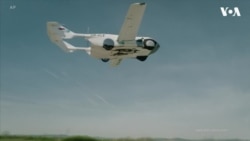ຖ້າມີລົດບໍ່ມີຄົນຂັບແລ່ນຢູ່ຕາມຖະໜົນໄດ້, ເປັນຫຍັງຈຶ່ງຈະມີເຮືອ ທີ່ບໍ່ມີຄົນຂັບແລ່ນ
ຢູ່ຕາມໜ້ານໍ້າໄດ້? ນັກຂ່າວວີໂອເອ ເຟທ໌ ລາປູດັສ ມີລາຍລະອຽດ ກ່ຽວກັບ ທີມງານ
ທີ່ກຳລັງສ້າງເຮືອຫຸ່ນຍົນຢູ່ ແລະ ສິ່ງທີ່ ເຂົາເຈົ້າຢາກໃຫ້ມັນເຮັດ, ເຊິ່ງ ພຸດທະສອນ
ຈະເປັນຜູ້ນຳເອົາລາຍລະອຽດມາສະເໜີທ່ານໃນອັນດັບຕໍ່ໄປ.
ເຮືອ USV ຫຼື ຍານພາຫະນະບໍ່ມີຄົນຂັບຢູ່ເທິງໜ້ານໍ້າ ລຳນີ້ ແມ່ນກຳລັງຖືກທົດລອງຢູ່
ເທິງໜ້ານໍ້າໃນລັດຟລໍຣິດາ.
ຄືກັນກັບເຮືອທີ່ບັງຄັບດ້ວຍຣີໂມດຈາກໄລຍະໄກລຳອື່ນໆ, ເຮືອທີ່ມີລຳຕົວເປັນຄູ່ລຳນີ້
ແມ່ນສາມາດຄວບຄຸມໄດ້ ໂດຍເຄື່ອງມືຢູ່ເທິງຝັ່ງ.
ແຕ່ກຸ່ມດັ່ງກ່າວ ກໍຍັງສາມາດປ່ຽນເຮືອລຳນີ້ ໃຫ້ເປັນລະບົບຄວບຄຸມຕົວມັນເອງໄດ້,
ປັດເຂ່ຍທຸກສິ່ງທຸກຢ່າງທີ່ເປັນອຸປະສັກໃນທາງຜ່ານອອກໄປ ເພື່ອທົດສອບວ່າມັນຈະ
ປະສົບຄວາມສຳເລັດ ໃນການປະເມີນຄວາມສ່ຽງຂອງມັນໄດ້ແນວໃດ ແລະ ຈະເດີນ
ທາງໃນສະພາບແວດລ້ອມທີ່ຊັບຊ້ອນດ້ວຍຕົວຂອງມັນເອງບໍ່.
ທ່ານ ສະຕຽນດຣາ ກຸບຕາ (Satyandra Gupta), ຈາກມະຫາວິ ທະຍາໄລລັດຄາລິຟໍ
ເນຍ ກ່າວວ່າ “ເມື່ອມັນເດີນທາງໄປພົບອຸປະສັກ, ມັນຈະຮູ້ສຶກໄດ້, ແລ້ວມັນກໍຈະຄຳ
ນວນວ່າ ສິ່ງກີດຂວາງພວກນັ້ນແມ່ນນ້ອຍໃຫຍ່ຊໍ່າໃດ ແລ້ວມັນກໍຈະຫາທາງຫຼີກເວັ້ນ
ເພື່ອຮັບປະກັນວ່າ ມັນຈະບໍ່ໄປຕຳເອົາສິ່ງກີດຂວາງນັ້ນ.”
ດ້ວຍມະນຸດເປັນຜູ້ຄວບຄຸມຢູ່, ເຮືອ USV ຈະສາມາດເຮັດໜ້າທີ່ຕ່າງໆຄື ສຳຫຼວດ
ກວດກາເບິ່ງຂົວ, ເບິ່ງສິ່ງແວດລ້ອມຕ່າງໆ, ທຳການຄົ້ນຫາ ແລະ ຫຼີກໄພໃນລະດັບໃໝ່.
ສ່ວນວ່າເຮືອ USV ອັດຕະໂນມັດ ຈະສາມາດເຮັດໄດ້ຫຼາຍຢ່າງໄປກວ່ານີ້.
ທ່ານ ສະຕຽນດຣາ ກຸບຕາ ກ່າວວ່າ “ໃນເມື່ອພວກເຮົາສາມາດເຮັດໃຫ້ມັນບັງຄັບຕົນ
ເອງໄດ້, ແລ້ວພວກເຮົາກໍຈະສາມາດເຮັດພາລະກິດໄປໄດ້ຫຼາຍກວ່າການກວດກາທີ່
ງ່າຍໆ. ແທ້ຈິງແລ້ວພວກເຮົາຈະສາມາດປະຕິບັດການກວດຄົ້ນ, ກູ້ໄພ ແລະ ການກອບ
ກູ້ໄດ້ເຊັ່ນກັນ, ແລະ ຍັງຈະສາມາດທຳການຂົນສົ່ງສິນຄ້າ ຫຼື ອະນາໄມເສດຫັກພັງ
ຕ່າງໆໄດ້. ສະນັ້ນມັນຈຶ່ງຈະມີຫຼາຍໆຢ່າງທີ່ສາມາດເຮັດໄດ້.”
ໃນທີ່ສຸດ, ບັນດາສະມາຊິກຂອງກຸ່ມນີ້ຈຶ່ງເວົ້າວ່າ, ວຽກງານຂອງເຂົາເຈົ້າທີ່ໄດ້ຮັບການ
ສະໜັບສະໜູນໂດຍມູນນິທິວິທະຍາສາດແຫ່ງຊາດນັ້ນ ແມ່ນກ່ຽວກັບ ການຂະຫຍາຍ
ຄວາມສາມາດຂອງມະນຸດ ໃນການສັ່ງຊາຫຸ່ນຍົນໃຫ້ເຫັນວຽກງານທີ່ໃຊ້ເວລາດົນ ຫຼື
ເປັນອັນຕະລາຍ ດ້ວຍການຊີ້ນຳ ພຽງເລັກນ້ອຍ, ແລະ ເຮັດໃຫ້ມັນໃຊ້ໄດ້ຢ່າງງ່າຍໆ.
ທ່ານ ຄາລ ວັອນ ແອລເລັນໄຣເດີ (Karl Von Ellenrieder) ຈາກມະຫາວິທະຍາໄລ
ແອັດແລນຕິກ ລັດຟລໍຣິດາ ກ່າວວ່າ “ຂ້າພະເຈົ້າຄິດວ່າ ຈະເວົ້າຕາມຄວາມຈິງແລ້ວ,
ມັນມີບາງຢ່າງທີ່ເຈົ້າມັກຢາກຈະໃຫ້ຄົນໃດຄົນນຶ່ງເຮັດ. ແຕ່ໃນເວລາດຽວກັນ, ຫຸ່ນຍົນ
ແມ່ນສາມາດຖືກສ້າງຂຶ້ນມາ ເພື່ອໃຫ້ມັນເຂົ້າໄປໃນສະພາບແວດລ້ອມທີ່ຮ້າຍແຮງ
ກວ່າ ຄືກັບເຄື່ອງຈັກທຸກໆປະເພດ, ຖ້າມັນບໍ່ງ່າຍສຳລັບຄົນທີ່ຈະໃຊ້ມັນ ແລ້ວມັນກໍຈະ
ບໍ່ຖືກນຳເອົາມາໃຊ້ຢ່າງແພ່ຫຼາຍ. ແລະ ສະນັ້ນ, ຍິ່ງມັນມີການສຳພັດກັບທຳມະຊາດ
ຫຼາຍຊໍ່າໃດ, ຂ້າພະເຈົ້າຄິດວ່າ ມັນກໍເບິ່ງຄືວ່າ ຈະຖືກນຳເອົາມາໃຊ້ຢ່າງກວ້າງຂວາງ
ກວ່າເກົ່າ.”
ບັນດານັກຄົ້ນຄວ້າທັງຫຼາຍ ກຳລັງເຮັດວຽກຢູ່ ຈົນໄປເຖິງມື້ ທີ່ຂະບວນຫຸ່ນຍົນເຮືອ ຈະ
ເປັນຄູ່ຮ່ວມງານກັບມະນຸດ ເພື່ອເຮັດໃຫ້ການເຮັດວຽກຢູ່ເທິງໜ້ານໍ້າມີປະສິດທິພາບ
ຫຼາຍຂຶ້ນ, ປອດໄພຂຶ້ນ ແລະ ຖືກລົງ.
If there can be driverless cars on the road, why not driverless boats on the water?Faith Lapidus has details of a team building a robotic boat, and what they want it to do.
This USV - Unmanned Surface Vehicle - on this Florida waterway is being put through its paces.
Like other remote controlled boats, this catamaran can be controlled by an operator on shore.
But the team can also put it into autonomous mode - throwing virtual obstacles in its path to test how successfully it assesses risk and navigates complex environments on its own.
"As it encounters obstacles - then it has to detect them, it has to figure it out how big those obstacles are and then it has to execute avoidance maneuver to make sure that it does not bump into the obstacles."
With a human at the controls, USVs could take tasks like bridge inspection, environmental monitoring, and search and rescue to new levels.An autonomous USV could do even more.
"Once we can make them autonomous, then we can go beyond simple surveillance task.We can actually perform search/rescue/ recovery type of task as well, and then also basically transport cargo or clean up debris.So there are a lot of other things can happen."
In the end, team members say, their worksupported by the National Science Foundationis about expanding human ability by engineering robots to do time-consuming or dangerous work with minimal supervision, and making them easy to use.
"I think that realistically speaking, there are certain things that you always want a person to do.At the same time though, robots can be built to go into much more extreme environments./// Just like with every machine, if it is not easy for people to use then it is not going to be widely adopted.And so, the more natural the interaction can be, I feel that the more likely it will be to be more broadly adopted."
The researchers are working toward a day when fleets of robotic boats will partner with humans to make working on the water more efficient, safer and less expensive.










